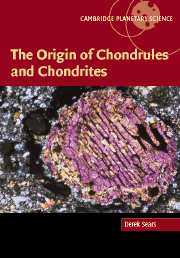Book contents
- Frontmatter
- Contents
- List of figures
- List of tables
- Preface
- 1 Historical introduction
- 2 Potential meteorite parent bodies
- 3 Chondrites and their main properties
- 4 Chondrules and their main properties
- 5 Theories for the origin of chondrules
- 6 Discussion of theories for the origin of chondrules
- 7 Discussion of theories for metal–silicate fractionation
- 8 So how far have we come and where do we go next?
- References
- Index
2 - Potential meteorite parent bodies
Published online by Cambridge University Press: 12 August 2009
- Frontmatter
- Contents
- List of figures
- List of tables
- Preface
- 1 Historical introduction
- 2 Potential meteorite parent bodies
- 3 Chondrites and their main properties
- 4 Chondrules and their main properties
- 5 Theories for the origin of chondrules
- 6 Discussion of theories for the origin of chondrules
- 7 Discussion of theories for metal–silicate fractionation
- 8 So how far have we come and where do we go next?
- References
- Index
Summary
Asteroids as potential meteorite parent bodies
The difficulties
Most meteorite researchers are confident that the near-Earth asteroids are the immediate parent bodies of the chondritic meteorites. Asteroid astronomers generally accept that most of the near-Earth asteroids originate in the Main Asteroid Belt, although some, probably around 10% (estimates have ranged as high as 50% in the past) are inert residues of comet nuclei (Wetherill and Chapman, 1988). However, when it comes to more precise links between asteroids and meteorites there are problems. As discussed below, the spectra do not fit; the commonest kinds of meteorites have spectra that match very few asteroids, while the majority of asteroids have spectra that match very few meteorites. Either the asteroids are camoflaging themselves or most of the meteorites are coming from very few sources. Just to compound the mystery, Eros, which has many of the compositional properties of an LL chondrite, has significant differences. We shall return to this below.
Before getting into details, it is important to stress the difficulties of linking asteroids, based on astronomical and remote sensing data, with the meteorites we analyze in the laboratory (Bell et al., 1989; Sears, 1998; Meibom and Clark, 1999).
First, we are only looking at the very surface of the asteroids with our photometric and spectroscopic techniques. It is possible that the interior is quite different from the surface where space conditions may have caused alterations.
Information
- Type
- Chapter
- Information
- The Origin of Chondrules and Chondrites , pp. 21 - 48Publisher: Cambridge University PressPrint publication year: 2004
